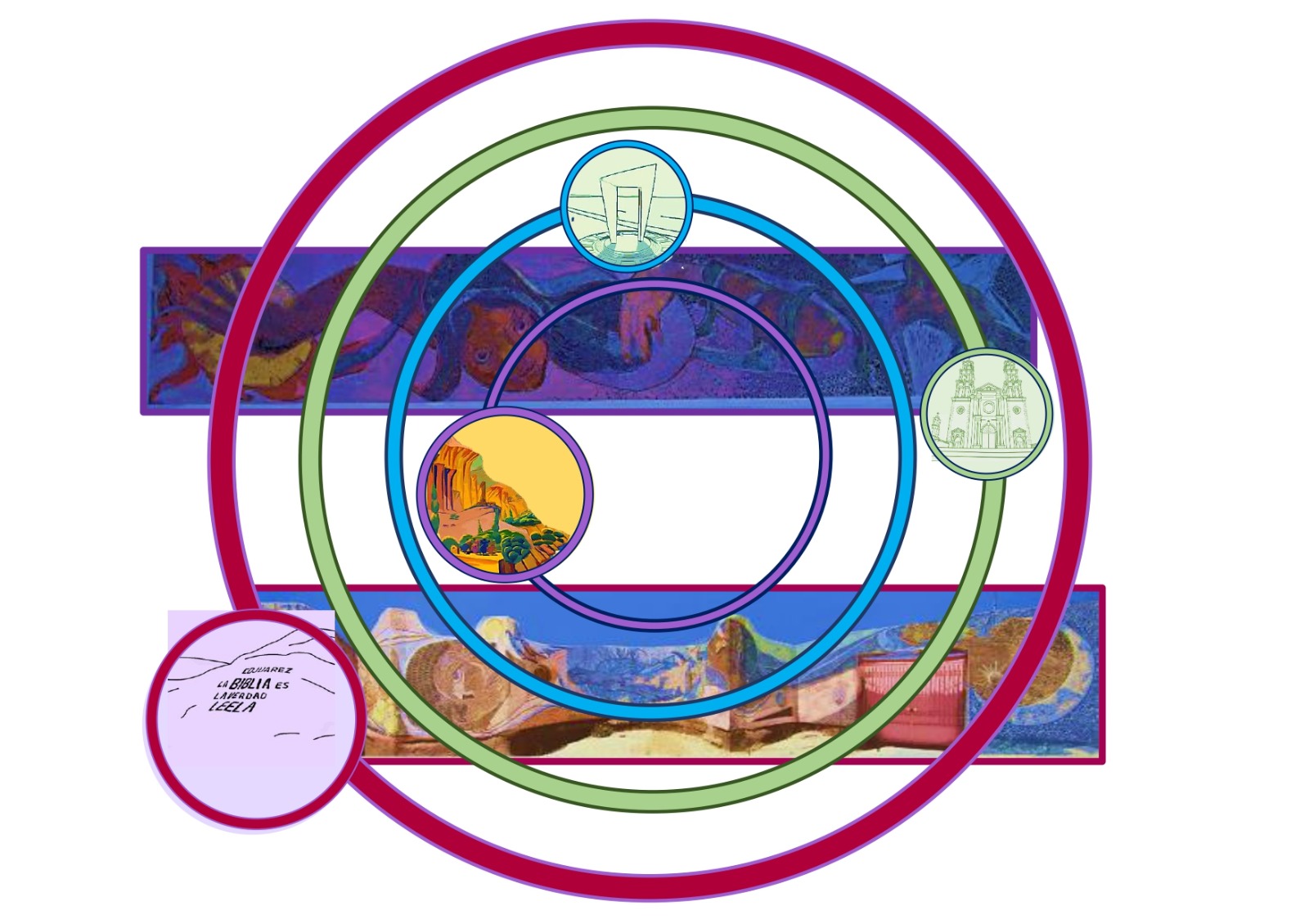Semiotic analysis of Mago Gándara's mural work in her studio home in Ciudad Juárez
DOI:
https://doi.org/10.54753/eac.v14i2.2370Keywords:
house, art, mural, borderland, iconographyAbstract
This article is the result of a research project whose objective was to document and analyze the large format mural work created by the Mexican-American artist Mago Gándara in her studio in Ciudad Juárez, Chihuahua, Mexico. Through a photographic survey, visual analysis, identification and classification of iconographic elements, and perception exercises with users, a visual semiotic study of the murals was carried out. It is based on the theory that sustains the aesthetic analysis from the phenomenological and iconographic method (Rodriguez 2005) that allows reading and translating the way in which the murals are linked to an affective dimension. The analysis was structured in three levels: (1) analysis of the form or description of representative elements, symbols, general meanings and primary stroke; (2) analysis of the meaning of color. It was based on color theory and its application in Gándara's artistic expression; and (3) analysis of composition or review of the structure of the images, characters, focal points and relationships between visual elements. In aspects of form and expression, the artist uses organic elements and strong strokes that evoke emotions such as happiness, balance, union, devotion, company, care, passion and time. In her work also highlights the use and implementation of color theory, the sensations and harmonies are objective, it has a proportion and location of colors that guide the gaze of the people who contemplate it and create a visual flow that can be interpreted to understand their messages. The study revealed that Gándara's work in her home studio focuses on themes such as creation, motherhood, childhood and community, discovering the relevance of her border context and bicultural identity in her artistic production.References
Biedarieva, S. (2015). The street artist as translator. Space and Culture, 19(1), 4-14. https://doi.org/10.1177/1206331215579752
Capek, M. (1996). Murals: Cave, Cathedral, to Street. Lerner Publications Co.
Ceniceros, B. I. (2022). Resistencias desde la frontera. Cartografía y manifestaciones. Universidad Autónoma de Ciudad Juárez.
Ceniceros, B. I. (2019). El artivismo en la frontera Ciudad Juárez-El Paso: hacia el derecho a la ciudad. Revista CIDOB d’Afers Internacionals, 123, 167-200. https://doi.org/10.24241/rcai.2019.123.3.167
Chowdhury, K. (2023). Visualizing Borders: M.I.A.’s “Borders” and Mural Art in Ciudad Juárez and El Paso. En Border Rules. Politics of Citizenship and Migration. Palgrave Macmillan, https://doi.org/10.1007/978-3-031-26216-6_6
Donis, A. D. (2016). LA SINTAXIS DE LA IMAGEN: introduccin al alfabeto visual. INDEPENDENT Publishing Group.
Estrada, Á. (2007). Mago: El Misterio de la Vida. Cortometraje. Productores: Ochoa, L.; Máynez A. y Estrada Á. https://sic.gob.mx/ficha.php?table=produccion_cine&table_id=662
Foladori, G. (2002). Una Tipología del Pensamiento Ambientalista. Universidad Autónoma de Zacatecas.
Gándara, M. (2013). El muro milagroso. Consejo Nacional para la Culturas y las Artes, Instituto Chihuahuense de la Cultura.
Giménez, G. (2009). Cultura, identidad y memoria. Frontera Norte, 21(41), 7-32. http://www.scielo.org.mx/pdf/fn/v21n41/v21n41a1.pdf
Givoni, B. (1969). Building Design Guidelines for Solar Energy Technologies. California University.
González, J.; Chavoya, O. y Noriega, C. (2019). Chicano and Chicana art, A Critical Anthology. Duke University Press.
Gregorek, J. (2009). Liberal Education after Antioch. Academe, 95(6), 35-40. https://www.jstor.org/stable/i20694581
Hal Marcus Gallery. (1977). Exhausted Triumph. Art Form Magazine of El Paso and Southwest Artist. 14-16.
Heller, E. (2012). La Psicología del color. Editorial Gustavo Gill.
Holmgren, D. (2002). Permacultura: principios y senderos más allá de la sustentabilidad. Ediciones Kaicron.
Itten, J. (2020). El arte del color. Editorial GG.
Juárez, M. (1997). Colors on Desert Walls: The Murals of El Paso. Texas Western Press.
Larraga, R. y Benítez Gómez, B. (2015). Transformando Comunidades para el Desarrollo Local: Un proceso de diseño participativo. Universidad Autónoma de San Luis Potosí.
Liddiard Cárdenas, A. E. y Hernández Orozco, G. (2021). Respuesta artística e iconográfica del muralismo urbano chihuahuense ante la contingencia por COVID-19. RECIE. Revista Electrónica Científica de Investigación Educativa, 5(2), 115-125. https://doi.org/10.33010/recie.v5i2.1324
Mc Harg. I. (2001). Proyectar con la naturaleza. Editorial Gustavo Gil.
Mazria, E.(1978). El libro de la Arquitectura Solar Pasiva. Editorial Gustavo Gil
Ochoa Lozano, L. E. y Ginez, D. (2019). Margarita Gándara Orona (1929-2018). Cuadernos Fronterizos, 15(45), 42-47. https://doi.org/10.20983/cuadfront.2019.45.16
Rodríguez, M. (2001). El caso de la identidad chicana y su ciudadanía étnico cultural. El Cotidiano, 18(108), 48-59. https://www.redalyc.org/pdf/325/32510806.pdf
Rodríguez, M. L. (2005). Introducción general a los estudios iconográficos y a su metodología. http://pendientedemigracion.ucm.es/centros/cont/descargas/documento4795.pdf.
Juárez M. (1998). Mago Orona Gandara: An Artist Voice Along the U.S. / Mexico Border. Anthology. Draft to be included in Kriste Linden (Ed.), Ordinary Women, Extraordinary Lives: Women in American History (pp. 2-19). Meyer Tennessee Technological University to be published by Scholarly Resources.
Vargas, G. (1995). Mago Gandara: A Woman Muralist on the Border. [monograph, Inter-American and Border Studies,] Center for Inter-American and Border Studies. University of Texas at El Paso.
Whitefield, P. (2017). Permacultura Esencial. Editorial Kaicron.

Published
How to Cite
Issue
Section
License
Copyright (c) 2025 Brenda Ceniceros Ortiz, Laura Elena Ochoa Lozano

This work is licensed under a Creative Commons Attribution-NonCommercial-ShareAlike 4.0 International License.
EAC declara una política de autoarchivo que les permite a los autores colaboradores publicar y difundir sus artículos en otros medios electrónicos (webs personales, repositorios institucionales, blogs, etc.) bajo los requisitos de la licencia CC BY-NC-SA 4.0 Como condición exige que suministren la información bibliográfica pertinente que acredite su primera publicación, lo que se autoriza solo después de que la EAC haya publicado la investigación.
El autor conserva los derechos de su obra publicada. La revista EAC le solicita únicamente que se le cite como fuente original (revista, editorial, DOI y URL de la obra), que no use la obra con fines comerciales u onerosos, pero sí que se mencione explícitamente la existencia y especificaciones de licencia antes mencionada.
EAC no cobra honorarios por procesamiento ni publicación de artículos. Todas nuestras gestiones son totalmente gratuitas.







